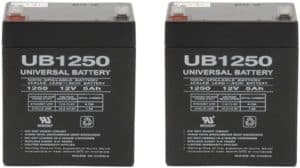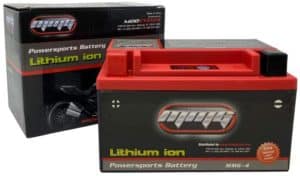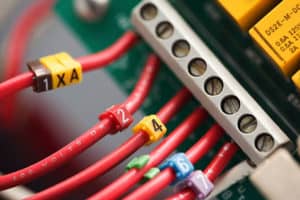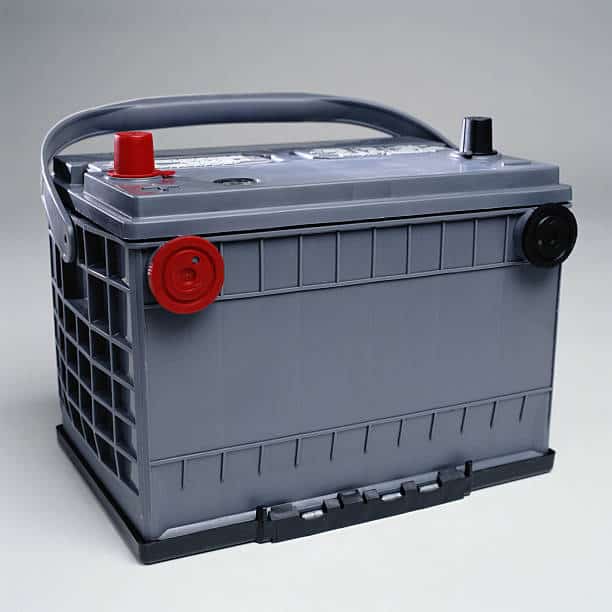Table of Contents
Comparison Chart
Types of batteries for bicycles
Lead-acid
 These are the oldest types of batteries still used in electric bikes. They are very similar to your car battery and work by creating an electrical charge through a chemical reaction. Its a complicated chemical reaction that produces an electrical charge, but you should know that the main components of your lead-acid battery are lead, separators, sulfuric acid, and water.
These are the oldest types of batteries still used in electric bikes. They are very similar to your car battery and work by creating an electrical charge through a chemical reaction. Its a complicated chemical reaction that produces an electrical charge, but you should know that the main components of your lead-acid battery are lead, separators, sulfuric acid, and water.
There are several types of lead-acid batteries. For example, there are sealed lead-acid batteries, open lead-acid, gelled electrolytes, and absorbed glass mats. Sealed lead-acid batteries are considered maintenance-free, which is what motivated their creation in the first place.
However, lead-acid batteries are being used less and less. A more efficient battery is replacing them with a much higher power-to-weight ratio, higher peak output level, and a longer-lasting discharge rate than the lithium-ion type of old lead-acid batteries.
So, suppose you happen to use any lead-acid battery. In that case, you should use it from time to time and discharge the battery until it weakens (you dont have to discharge it entirely because that creates wear and tear on the battery, which leads to other problems in the long run). Then fully recharge it right after discharge and while it is still warm (but do not overcharge it because the gases could build up too much pressure and be released through the safety valve. This would also reduce the number of active agents available to create an electrical charge through this chemical reaction process).
Lithium-ion
 Lithium-ion (L-ion) batteries are a relatively modern technology spreading throughout. Initially developed, we needed lighter, smaller batteries that could still power our electronic devices, like our cell phones. Cell phones were a huge motivator for the creation of new battery technology, and improvements in battery design can largely be attributed to the fact that these communication devices have taken over the world. Everyone has a cell phone, which accounts for billions of batteries, and the industry has become massive because of these and all the other portable electronic devices that society has become dependent on these days.
Lithium-ion (L-ion) batteries are a relatively modern technology spreading throughout. Initially developed, we needed lighter, smaller batteries that could still power our electronic devices, like our cell phones. Cell phones were a huge motivator for the creation of new battery technology, and improvements in battery design can largely be attributed to the fact that these communication devices have taken over the world. Everyone has a cell phone, which accounts for billions of batteries, and the industry has become massive because of these and all the other portable electronic devices that society has become dependent on these days.
Many lithium-ion batteries are variations of this original design, and each improves on its predecessor. For example, the second form of Li-ion batteries, after abandoning the positive lithium metal and negative anode of the LiCO2 compound, was a lithium cobalt oxide (LCO) battery that used the latter as the ionic compound of lithium. This had safety issues as well as less than ideal power potential.
Modern Li-ion batteries are therefore safer, more powerful, lighter, and most importantly, more compact than lead-acid batteries, making them perfect for powering your electric bike. As long as you take care of it and regularly charge and discharge the batterys electrical charge, it will last for decades. They have a longer life span, meaning they can go longer periods between uses than their predecessors without potentially losing energy. Lead-acid batteries were known for losing energy due to corrosion, crystallization, or other problems.
The only Cons with L-ion batteries are that they cost more to produce because of the materials used, which means they cost more to buy for us consumers. But because of their very long life and improved power statistics in all respects, they are the best choice for most bike manufacturers today and are in most bike models right off the assembly line.
Charging your electric bike
If you have an electric bike and depend on it for regular travel, you need to know about its battery and charge. By learning about your electric bikes battery and its charge, you will be better able to take care of it.
Please take out your battery charger, plug it into an electrical outlet and turn on the switch. The charger light should glow green, indicating that the charger is good.
Now, connect the battery end of the charger to the charging port and turn on the power; the light on the charger should glow red, indicating that charging is underway.
Charge the battery for the length of time recommended in your user manual; this may take between 3 and 12 hours. When the battery is fully charged, the charger light will turn green, indicating that charging is complete, and you can remove the charger from your electric bike. This happens when everything is working properly.
However, sometimes your battery will not be charged even after it is fully charged. There may be several reasons for this. Lets consider them one by one.
Why won’t your electric bike charge?
Are you using the right charger?

If you have more than one electric bike, there may be confusion between the chargers. Check the label on the charger. The chargers voltage should be slightly higher than the batterys voltage. For example, a 39-volt charger to charge a 36-volt battery.
No green light comes on when the charger is plugged into the mains.
Your charger may have a built-in fuse or circuit breaker. Check and correct it. If the charger works now, use it.
If the fuse or circuit breaker is intact, take a voltmeter or multimeter and test the voltage output of the charger. If the voltage is zero or less than the battery voltage, the charger is defective, and get a new charger.
Check the mains current and the charger port.
Check the port with the multimeter and replace the defective charger. The charger port may be loose, or there may be a loose connection.
Check if the battery has reached the end of its life.
Remove the step, physically examine the battery and look for leaks. If the battery appears to be in good condition, test the battery voltage.
The actual battery voltage is slightly higher than its stated value. For example, the actual voltage of a 36-volt battery may be 38 or 39 volts.
If the battery voltage is low, the battery should be replaced. Check the battery history and ensure it is old and has lived its whole life. If you are unsure, ask a battery technician for help.
The charger light turns green shortly after charging.
Continue charging for the recommended time. The battery should be tested if the charged battery is not delivering its rated power (bike speed and mileage).
An aged battery can lose voltage quickly. Check the history and age of the battery and ask the technician for help if necessary.

